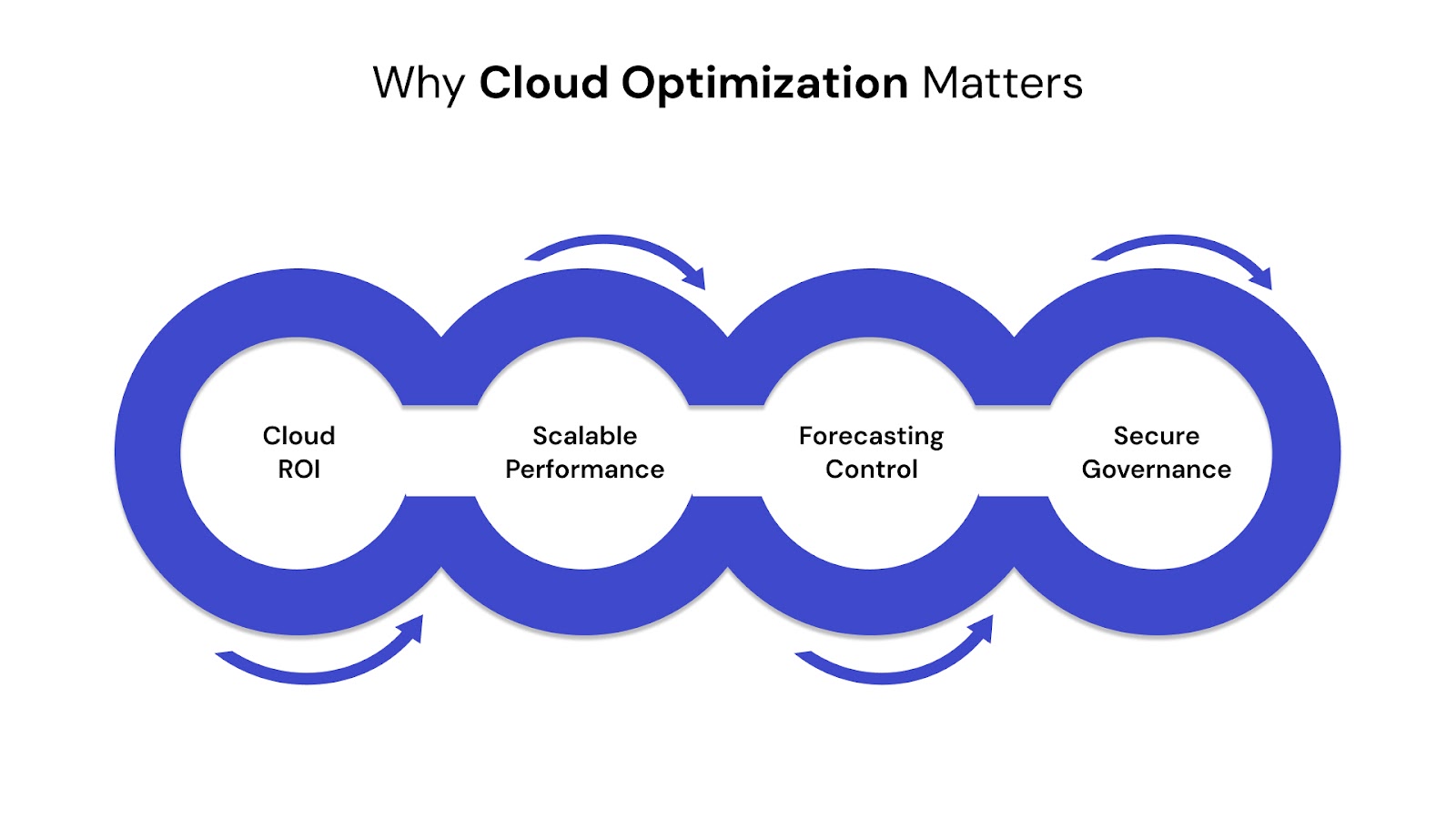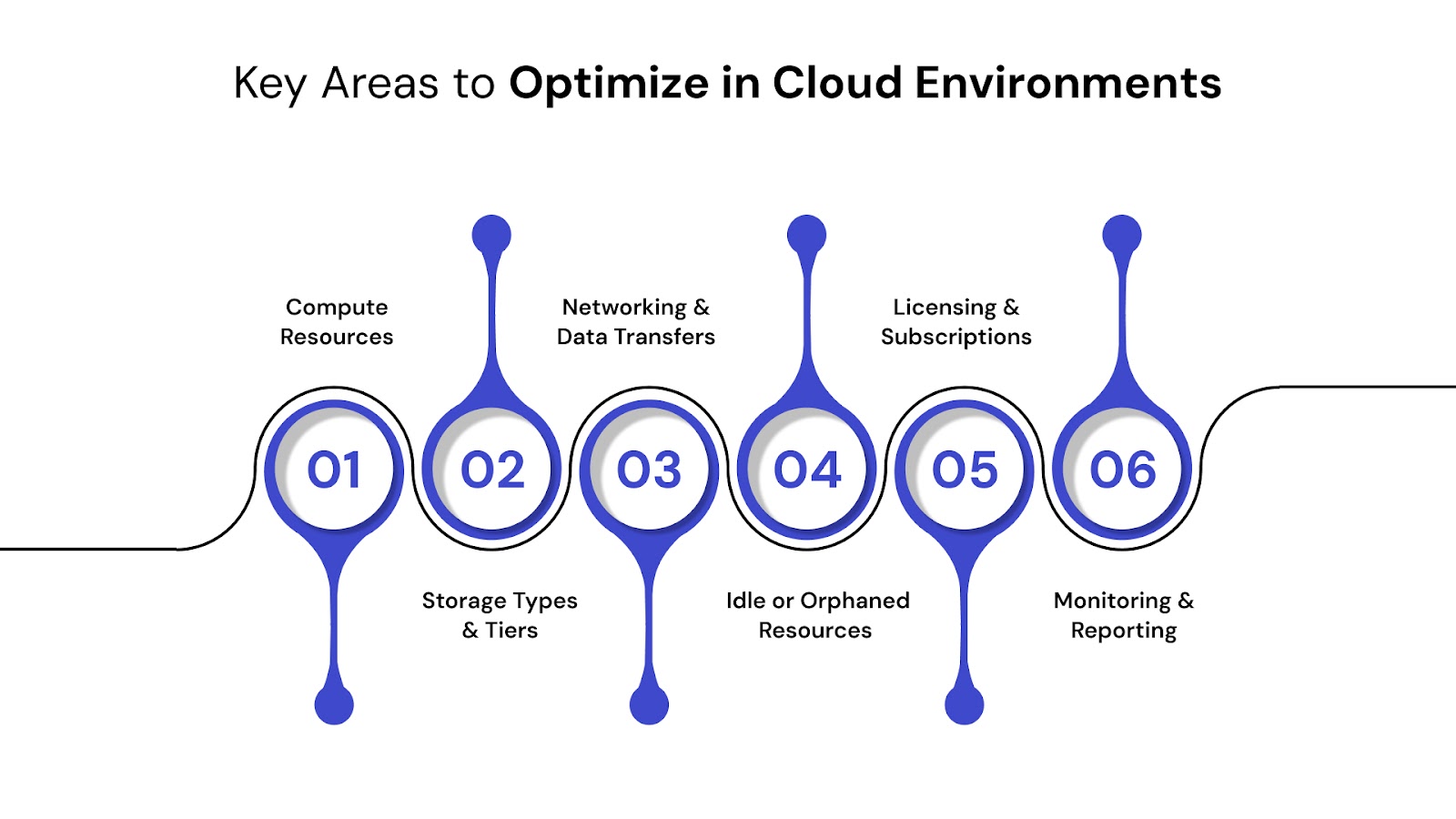.png)

Cloud adoption has skyrocketed in recent years—94% of enterprises now use cloud services, yet nearly a third report they don’t fully understand where their money is going. With cloud complexity increasing, your organization could be leaving performance gains and cost savings on the table.
Cloud optimization is the practice of strategically managing cloud resources to strike the perfect balance between performance, cost-efficiency, and compliance. It’s not just about cutting bills—it’s about empowering your team to scale smarter, respond faster, and avoid the pitfalls of cloud sprawl.
In this article, we’ll dive into what cloud optimization truly means, why it matters, and how to implement proven cloud optimization best practices that drive real results.
TL;DR (Key Takeaways):
At its core, cloud optimization is the process of strategically configuring, provisioning, and managing cloud resources to achieve maximum performance at the lowest possible cost. It’s not a one-time activity—optimization is continuous, adapting as your workloads evolve and your business scales.
Cloud optimization doesn’t just mean reducing costs (though that’s a critical part). It also ensures your infrastructure is secure, scalable, and aligned with business goals. From identifying underutilized instances to refining architecture and automating scaling policies, cloud optimization makes sure you’re not paying for more than you use nor compromising on service quality.
While “cost-cutting” often implies sacrificing capabilities, cloud cost optimization is smarter. It's about aligning spending with actual usage—optimizing cloud costs without sacrificing performance. For instance, right-sizing instances, scheduling non-production workloads, and leveraging automation can reduce waste while improving performance metrics.
Here, you can read this related blog from QuartileX on how smarter data analytics modernization can power better decisions, which is foundational to effective cloud optimization.
As cloud infrastructure becomes increasingly central to business operations, so do its inefficiencies. A misconfigured workload, idle virtual machine, or untagged resource can snowball into thousands of dollars in monthly waste.
Here’s why cloud optimization should be a strategic priority:

Whether you're on AWS, Azure, or Google Cloud, cloud providers charge based on consumption. Optimizing cloud cost ensures you only pay for what you use and gain full value from every dollar spent.
Optimization helps you right-size resources and eliminate bottlenecks, improving responsiveness and uptime for mission-critical applications.
With optimization, IT and finance teams gain better visibility into cloud costs, enabling accurate budgeting and long-term planning. Cloud cost optimization benefits extend far beyond IT—they impact the bottom line.
Unused or misconfigured resources often pose security risks. Cloud optimization includes resource tagging, policy enforcement, and access management to reduce vulnerabilities and support compliance.
As cloud adoption accelerates, so do the risks of inefficiency. Enterprises are realizing that the cloud’s promise of flexibility and scalability comes at a cost, especially when resources are overprovisioned or poorly managed.
According to Flexera’s 2025 State of the Cloud report, organizations waste over 28% of their cloud spend on unused or misallocated resources. McKinsey further reports that cloud optimization can reduce costs by 15–25% while improving business agility. This underscores that optimization is no longer optional—it’s a critical lever for ROI.
Unmanaged cloud environments often suffer from:
The impact goes beyond IT budgets. Without a solid cloud optimization implementation strategy, businesses lose out on performance gains, security hardening, and strategic agility.

Optimization is a layered process—it’s not just about cost, but how efficiently your entire architecture runs. Below are six high-impact areas:
Mis-sized virtual machines and idle instances are common culprits of inflated cloud bills. Right-sizing and workload matching can lead to instant savings.
Not all data needs high-performance (and expensive) storage. Leveraging archival tiers like Amazon S3 Glacier or Azure Blob Storage cold tiers can dramatically reduce costs.
Data transfer across regions and egress traffic add hidden costs. Route optimization and load balancing are vital for managing cloud optimization best practices in networking.
Forgotten dev/test environments, unattached storage volumes, or untagged assets continue to accrue charges. Regular audits and automation help clean these up.
Unused or underutilized licenses (especially SaaS or BYOL setups) often fly under the radar. Regular reviews and license optimization can deliver savings with zero disruption.
Granular visibility is non-negotiable. Without monitoring usage trends and performance metrics, your optimization efforts remain reactive rather than proactive.
Cloud optimization isn’t a one-time effort; it’s a continuous practice rooted in visibility, automation, and strategic decision-making. Here are proven best practices to help you get the most value out of your cloud investment.
One of the core pillars of optimizing cloud costs is ensuring that compute, memory, and storage resources are provisioned to match real-world usage, not assumptions. Use performance metrics and historical usage data to resize instances and services.
Pro tip: Incorporate auto-scaling where possible. It enables resources to expand or contract dynamically, improving cost-efficiency and responsiveness.
Reserved Instances (RIs) are ideal for predictable, steady workloads and can reduce costs by up to 75%. Spot instances, on the other hand, are great for batch jobs and non-critical workloads that can tolerate interruptions, often at discounts of 80–90%.
Balancing both provides flexibility and cost efficiency.
Regular audits are essential. Dormant VMs, unattached storage, unused IPs, and outdated snapshots often persist unnoticed, racking up costs. Automation tools can flag and decommission these resources safely.
Automated monitoring provides real-time visibility into usage patterns and performance metrics. Tools like AWS CloudWatch, Azure Monitor, and third-party solutions like Datadog or CloudZero can alert teams about anomalies and optimization opportunities.
Data movement between regions or clouds incurs bandwidth fees. Avoid unnecessary cross-zone transfers, and use CDN services and object storage tiers to manage costs without sacrificing speed.
Tag all resources by project, owner, and environment (e.g., dev, test, prod). This simplifies cost attribution, improves accountability, and enables better forecasting.
Tagging is also essential for building a FinOps culture—a framework that aligns engineering, finance, and business teams to manage cloud spend collaboratively.
A structured implementation approach ensures consistency and long-term success. Here’s how to roll out cloud optimization in your organization:
What do you want to optimize—cost, performance, reliability, or all three? Define measurable KPIs such as cost per transaction, resource utilization rate, or availability targets.
Use tools to assess current usage, identify bottlenecks, and flag underused services. This assessment will inform which workloads to refactor, resize, or retire.
Leverage cloud-native cost management dashboards or advanced third-party tools like Apptio Cloudability, CloudHealth, or nOps to monitor usage and optimize in real time.
Successful cloud optimization implementation requires collaboration between IT, DevOps, finance, and product teams. A FinOps framework ensures cost-awareness is embedded across departments.
Build regular review cycles to assess savings, track KPIs, and refine your optimization strategy. Cloud environments evolve—so should your optimization approach.
Selecting the right tools and platforms can significantly accelerate your cloud optimization efforts. Whether you're using a single provider or working in a multi-cloud or hybrid environment, the goal remains the same: reduce waste, improve visibility, and align cloud investments with business outcomes.
Each major cloud platform offers built-in tools for cost visibility and resource optimization:
For cross-cloud visibility and more advanced features, these solutions are widely adopted:
Read more here: QuartileX shares how AI-powered governance and optimization solutions play a vital role in intelligent cost control and long-term cloud performance.
At QuartileX, we bring together technical expertise and business strategy to deliver holistic cloud optimization solutions. Our services include:
Explore our Secure Cloud Solutions page to see how we help modern businesses streamline cloud infrastructure while improving performance and cost predictability.
Despite the benefits, cloud optimization comes with its own set of challenges. Recognizing and addressing them early can prevent wasted time and resources.
Without unified dashboards or clear reporting, organizations often lose track of resource usage across teams and platforms. This leads to unmonitored spending and inefficient provisioning.
Solution: Implement cost tagging, enforce governance, and use centralized monitoring tools.
Overestimating demand leads to overprovisioning, which compounds costs over time. Similarly, idle instances remain "on" even when not needed.
Solution: Leverage autoscaling, right-sizing, and scheduled shutdowns for dev/test environments.
Cloud pricing is notoriously difficult to decode, especially across providers with varying SKUs, regional rates, and bundled services.
Solution: Use third-party optimization platforms and consult with experts like QuartileX for pricing strategy audits.
When teams operate in isolation, cloud cost accountability becomes fragmented.
Solution: Adopt a FinOps model where engineering, finance, and operations share responsibility for cloud efficiency and cost optimization.
Cloud optimization is not simply a budgeting exercise—it’s a strategic necessity in today’s agile, tech-driven business environment. From right-sizing and automation to improved visibility and governance, organizations that treat optimization as an ongoing discipline gain significant advantages: lower cloud bills, better app performance, and greater scalability.
By following cloud optimization best practices and investing in the right tools and expertise, you can maximize the ROI of your cloud investments without compromising on performance.
How QuartileX Can Help
Whether you're looking to cut costs, improve performance, or build a long-term cloud strategy, QuartileX can support your optimization journey. Our team delivers:
Want to learn how our team can support your cloud goals? Get in touch with QuartileX today for a free consultation.
1. What is cloud optimization?
Cloud optimization is the process of configuring, managing, and allocating cloud resources to maximize performance while minimizing costs and waste. It involves techniques like right-sizing, automation, and monitoring to align infrastructure with actual workload needs.
Learn more about strategic infrastructure decisions in our post on Cloud Optimizations: Best Practices for 2025
2. Why is cloud optimization important for businesses?
Cloud optimization is essential to prevent overspending, improve performance, and ensure that cloud investments are delivering measurable ROI. Without it, businesses risk underutilizing resources, facing unpredictable costs, and limiting their scalability.
3. What are the benefits of cloud cost optimization?
The benefits of cloud cost optimization include:
Explore how we deliver these benefits through our secure cloud services.
4. What are some cloud optimization best practices?
Some widely adopted cloud optimization best practices include:
5. How is cloud optimization implemented?
Cloud optimization implementation typically involves a structured process:
6. Is cloud optimization a one-time activity?
No, optimizing cloud cost is a continuous process. Because cloud usage and pricing constantly evolve, ongoing monitoring and adjustments are required to maintain efficiency, prevent budget overruns, and adapt to new business needs.
From cloud to AI — we’ll help build the right roadmap.
Kickstart your journey with intelligent data, AI-driven strategies!